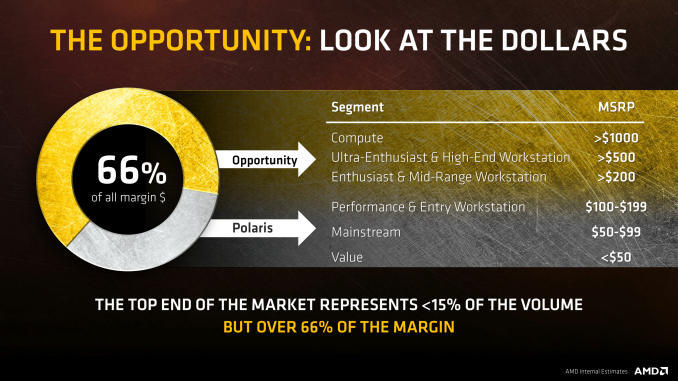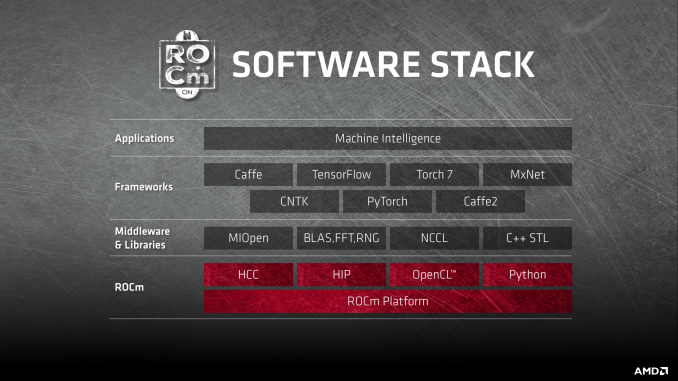AMD Unveils the Radeon Vega Frontier Edition: Vega Starts in the Pros
by Ryan Smith on May 17, 2017 2:45 AM EST- Posted in
- GPUs
- AMD
- Radeon
- Machine Learning
- Vega
- Radeon Pro
- Vega Frontier Edition
Vega Frontier Edition’s Target Market: AI, Machine Learning, and other Professionals
As important as the Vega hardware itself is, for AMD the target market for the hardware is equally important if not more. Vega’s the first new high-end GPU from the company in two years, and it comes at a time when GPU sales are booming.
Advances in machine learning have made GPUs the hottest computational peripheral since the x87 floating point co-processor, and unfortunately for AMD, they’ve largely missed the boat on this. Competitor NVIDIA has vastly grown their datacenter business over just the last year on the back of machine learning, thanks in large part to the task-optimized capabilities of the Pascal architecture. And most importantly of all, these machine learning accelerators have been highly profitable, fetching high margins even when the cards are readily available.
For AMD then, Vega is their chance to finally break into the machine learning market in a big way. The GPU isn’t just a high-end competitor, but it offers high performance FP16 and INT8 modes that earlier AMD GPU architectures lacked, and those modes are in turn immensely beneficial to machine learning performance. As a result, for the Vega Frontier Edition launch, AMD is taking a page from the NVIDIA playbook: rather than starting off the Vega generation with consumer cards, they’re going to launch with professional cards for the workstation market.
To be sure, the Radeon Vega Frontier Edition is not officially branded as a Pro or WX series card. But in terms of AMD’s target market, it’s unambiguously a professional card. The product page is hosted on the pro graphics section of AMD’s website, the marketing material is all about professional uses, and AMD even goes so far as to tell gamers to hold off for cheaper gaming cards later on in their official blog post. Consequently the Vega FE is about the closest analogue AMD has to NVIDIA’s Titan series cards, which although are gaming capable, in the last generation they have become almost exclusively professional focused.
AMD launching a new GPU architecture in the professional space first is a very big deal. Simply put, the company has never done it before. Fiji, Hawaii, Tahiti, Cayman, Cypress, and more all launched in consumer cards first. The traditional wisdom here is that launching in the consumer space first allows consumers to get their hands on the cards now, while professional products undergo further validation and refinement to meet the higher standards of professional users. Put another way, consumers serve as the final layer of debugging a new GPU, offering mass testing unlike anything else. So for AMD to launch in the pro market first indicates that they have an extensive amount of faith in the product.
As for why AMD would want to do this, the following AMD slide says it all.
Simply put, professional cards sell for higher prices than consumer gaming cards, sometimes significantly higher. As a result it makes all the sense in the world to sell their first Vega cards to professional users who are willing to pay $1000+ for a compute card, as opposed to consumers who would like to pay half that. More than anything else, AMD’s overall lack of profitability has come from a lack of high-margin parts to help offset their ongoing operational costs, and launching Vega as a pro card is one of the steps AMD is taking to correct that.
For pro users then with sufficiently deep pockets, they’ll be the first to get a crack at AMD’s latest high-end video card/accelerator. AMD calls this line of cards the Frontier Edition, and while the name is clearly AMD being cheeky towards NVIDIA’s Founder’s Edition line, the analogy isn’t completely off-base. AMD’s target market is going to be machine learning developers, game developers, and others who AMD believes need early access to the cards for future development. The advantage of this route is that, particularly in the case of machine learning, this allows developers to get a jump on testing a new architecture ahead of placing a large order for server cards. So in a sense, one of the roles of the Vega FE is to prime the pump for selling Radeon Instinct MI25 cards later in the year.
As for consumers, while this is as big a change for them as it is for AMD, it’s likely a hallmark of what to expect in the future for new high-end GPU launches. For AMD gamers who have been holding out for Vega, it’s clear that they’ll have to hold out a bit longer. AMD is developing traditional consumer gaming cards as well, but by asking gamers to hold off a little while longer when the Vega FE already isn’t launching until late June, AMD is signaling that we shouldn’t be expecting consumer cards until the second half of the year.
Wrapping things up, it’ll be very interesting to see how this strategy goes for AMD. NVIDIA has been very successful in the machine learning market over the last year, and if AMD can replicate NVIDIA’s success, not only will they make the machine learning market far more competitive for everyone, but they also stand a very good chance of finally turning the corner on both profitability and their overall share of the HPC market.













134 Comments
View All Comments
Yojimbo - Friday, May 19, 2017 - link
This claim: "Regarding Google, they seem to have announced a bit of a coup with their tpu2."I think calling it a "bit of a coup" is an overestimation of its likely potential.
"If volta was a better fit for them they wouldn't have needed to create their own asic."
The TPU2 has been in development for 2 years, probably. Without seeing more information about this TPU, how it's actually being used within Google and their cloud, and real-world performance comparisons between the TPU and Volta, you can't assume that the TPU is better. This TPU is an active area of research for Google. It's something they seem to have committed manpower and energy to, and I'm sure it's something they have more plans for in the future. I wouldn't expect them to suddenly find out a few months back "Oh, Volta can do more than we expected, let's just pull the plug on this." So you need more information to make a determination as to what the real world advantages of these TPUs really are.
More importantly you aren't arguing against my point here, since you said "If Volta was a better fit FOR THEM..." (emphasis is mine). My post was focused on the overall machine learning market potential. In fact I said "If the goal is to apply machine learning and only machine learning to a problem, the TPU may be preferable. But if the data should also be processed in other ways, it will probably make more sense to use a GPU." Google is certainly a company that has massive machine learning workloads that consist entirely of machine learning training and inferencing. However, I don't think such workloads will be the majority of machine learning workloads going forwards. That's why, even if this TPU does have a significant price/performance and w/performance advantage over GPUs (and again, what advantage it does have is not clear at this point), it still doesn't qualify as a "coup".
"Also, these new tpus appear to be vastly different from the first gen given that it is end to end sp."
I think it's half-precision not single precision. But in any case, that's actually a disadvantage for the TPU, as I pointed out. They don't give the option for network quantization. The advantage of the end to end half-precision is that they can do both training and inferencing without moving the data around, something that GPUs can also do. GPUs, however, can extend this same advantage to mixed-workload machine learning.
"As I've said, they aren't even competitors right now. So, you don't need to defend the honor of Nvidia to me:)"
This is a counter-productive thing to say. I'm not defending the honor of NVIDIA, I'm analyzing the market.
The TPU looks interesting. Particularly because it's not just an ASIC. It is capable of scaling. So they've done a lot of work on networking and partitioning workloads, etc. As far as NVIDIA is concerned, it is a threat, if only because it means Google will be buying less GPUs from them. It also obviously poses a question for the future of the machine learning compute market: Will ASIC architectures force GPUs out of the majority of machine learning workloads? Calling it a "coup" is an answer to that question implying that it is a significant threat to disrupt the machine learning compute market. I think such a judgment at this point is hyperbolic and unwarranted.
VulkanMan - Wednesday, May 17, 2017 - link
Ryan, the card Raja showed was 8+6 for power. So, the renderings were not correct.https://s12.postimg.org/5ievshwu5/x2_GNw_Bxw2_X-b_...
Ryan Smith - Wednesday, May 17, 2017 - link
The renderings are the images officially released to the press, so they're more likely to be the correct ones. But we shall see. This wouldn't have been the first time someone has held up a dummy card or prototype.VulkanMan - Thursday, May 18, 2017 - link
On Raja's AMA on reddit, he just said: "I grabbed an engineering board from the lab on the way to the Sunnyvale auditorium, and that boards works well with a 6 and an 8 pin. We decided to put two 8 pin connectors in the production boards to give our Frontier users extra headroom"Cellar Door - Wednesday, May 17, 2017 - link
No consumer cards until the 2nd half? That is a fail, fail, fail.The RX5xx series is already a rehash that no one cares about. I'm really hoping Nvidia decides to cease upon this opportunity and do a 1.. 2.. punch with launch of a consumer Volta in the form of a GTX 2080 series card.
At this point it has just been too long and I'm sick and tired of the ridiculous hype train.
HEAR THIS AMD! - I, for one am deciding not to 'hold out' for a little longer, Nvidia is getting my money this year. It's been too long.
MsYunaAyashi - Thursday, May 18, 2017 - link
very well then. Good bye!Onasis - Wednesday, May 17, 2017 - link
Well idk how this is posible but my r9 390 has 125 fps on 2k paired with 7700k stock not hitting 125 but sitting on it. So as far im concerned I dont need vega or volta, but do I want them? Absolutely yes. Besides learning from the history of this two give a month or two after release and u will be buying Vega for 250$Chaser - Wednesday, May 17, 2017 - link
AMD GPUs are becoming 2nd hand junk or vaporware. Only their fanboys care anymore.supdawgwtfd - Wednesday, May 17, 2017 - link
Bahahahaahhaahahhahah!!!!Wow... biased much?
fanofanand - Wednesday, May 24, 2017 - link
I think you accidentally typed in anandtech, when you meant to put in wccftech